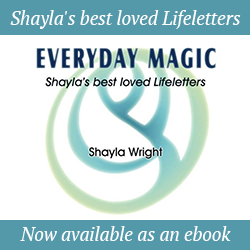
In these times of wildness, in these times of chaos, heartbreak and despair, we are being called. Drawn relentlessly into a deeper connection with ourselves, and with each other. Into a new way of moving through our days and our nights.
I spoke with an aunt of mine one day long ago, about ‘moving with our own inner rhythm.’ She looked at me as if I was delusional. I received a strong hit in that moment of the severe genetic coding we have received as women, passed down through the generations. There’s nothing in that transmission that breathes even a whisper about a true inner rhythm. I imagine it’s just the same with men. Can you imagine the Marines tolerating that idea for one moment? It’s the kind of thing that would lead to court martial.
The sense of the power and beauty of an inner rhythm came to me early on. My late uncle, the famous photo journalist David Douglas Duncan, who was also a Marine, lived with Pablo Picasso for years in the south of France. He created some compelling and beautiful books about his life with Picasso. I grew up with those books; and it was always very clear to me, as I waded through that magic world as a child, that Picasso was living in impeccable alliance with his own inner rhythm. Even now, looking at those books, I feel it in every photograph: in the way he sits, and moves, in the depth of his intensity and in his playfulness. The maestro is vibrating with potency, listening to something deep within, remaining deeply faithful to that.
In a training I did recently we had an assignment. We were asked to spend time discerning our own inner rhythm, seeing how much we could actually align ourselves with it. I couldn’t even really do the practice at first. I was fascinated by the topic, but it felt so elusive. I would circle wistfully around it, without really being able to dive in. My life on most days felt like a runaway horse that I was riding. How was I supposed to rein that horse in and get synced up with my own inner rhythm? I was afraid to feel my own inner rhythm, and I was ashamed that I abandoned this part of myself, that I was so far away from my sovereign nature. I thought my own true rhythm might ask me to go to a green field and lie down for three years.
Once we lose touch with our inner rhythm, we get lost. Our original movement is replaced by something rote, a substitute for the beauty of authentic movement and deep stillness. A while ago I was sitting at the beach, talking to a young woman I know and love. She is a highly aware mother of two young children, who also runs a couple of organic restaurants and juice bars. Her life is a dance of constant movement from morning ’till night. She said something, as she played with her children in the sand, that stayed with me for days: “It’s hard, being so busy all the time, but it keeps you in a place where you don’t have to feel so much. I notice, when I finally find a few precious moments to rest, that my system isn’t really ready to sink down and feel all of the things I didn’t have time to feel before that moment.”
This kind of movement can become a trance, an addiction to speed that lives in our cells. Our whole post modern society is moving inside that rhythm, even though we say we hate it. Rushing, if you are able to feel it, comes from fear, and also protects us from fear.
We can also get stuck in stillness. Instead of the frantic edgy restlessness, we sink into a bog, a state of apathy, listlessness, without energy or motivation. Sometimes there’s a deep core of exhaustion at the heart of this state.
If you look at our culture, you’ll see a lot of people swinging back and forth between these two states, often using drugs to keep them up or bring them down. We have not exactly mastered a healthy relationship to the vitality and joy that joins movement with stillness.
Other cultures have gone into this very deeply. The ancient yogic philosophers of India describe a middle state, a place of balance, light and goodness which they call ‘sattwa.’ I heard it described once as ‘infinite dynamic poise’ and realized I have felt it embodied by cats, when they are resting outside in the sun. The cat is profoundly relaxed, almost melted into the ground; but the very second something moves in the grass, it becomes a liquid bolt of very precise movement. There is no gap—the movement flows directly from the depth of the stillness.
In my work as a coach, and in my own practices, I’ve discovered ways of getting closer to this inner rhythm, which is unique in the way it lives and moves in each of us. One way is to practice taking a tiny pause, right in the midst of activity. A pause in which you call yourself into full presence, into stillness, into the body. It sounds easy doesn’t it? It’s actually extraordinarily difficult to take such tiny pauses—the momentum of activity just wants to keep rolling along. If you persist, you’ll notice a different quality starting to penetrate your movement.
Another way is to listen, throughout the day, to what your inner being and body want to do, and see how much room you have to do that. My clients and I have been surprised to find that our schedules are not half as confining as the force of our habits. What stops me from resting briefly at a certain time of day is often not an outside influence—it’s something that lives inside me that says, “Keep going, don’t stop.” What stops me from getting up off the coach and striding out the door for a walk is the same thing—a deeply habitual pattern that requires energy and awareness to wake up from.
Moving from our own inner rhythm is a radical practice. It shakes up our whole world. Since almost no-one around us is doing it, it requires a strong intention to embody this way of being. Underneath our patterns of stillness and movement are feelings we don’t want to meet, and powerful gifts that are asking for expression. In order to claim our own place in the wildness of this world, to open to a higher consciousness, and embody our sovereign nature, we have no choice but to pass through that gateway.
This first
courageous life
in fact, has already
gone ahead
has nowhere to go
except
out the door
into the clear air
of morning
taking me with it,
nothing to do
except to breathe
while it can…
David Whyte ‘Second Life’
with love,
Shayla
Photo by Jeff Isaak on Unsplash
4 Comments
Join the conversation and post a comment.



Holidays
Holy Days
Cleaning
House
For my death
should not bring
the stuff of burden
to others
as I pass
by
So timely your story, it was only a few days ago, on my birthday a friend asked what would I say, looking back, to my child self – these were the words that came; “I’m so proud of you my little one, you managed to stay true to yourself, no punishment big or small, no beating, or belittling could bend you into submission, or have you stray from your own inner voice, inner truth. You held on steadfastly and strong. I thank you for that.
<3
my words might seem disjointed … and the rhythm a bit loose …. hence I hope something worthwhile for you is seen. As a result of a personal query into why my skin is unbearably itchy at times I heard
”” nervous about what I might encounter””; key word ‘might’. And from this momentary where-with-all the following showed itself. The beginning once again.
in-joy Charon
shrouded in-looking
touched un-opened
leaves an unseen shore
“I thought my own true rhythm might ask me to go to a green field and lie down for three years.” This sentence struck me strongly, Shayla. I have had that same feeling myself:If I let go of my habitual drive to be busy and allow myself to fully rest, there is a fear that I might never want to move again! This isn’t true, and the more I allow myself authentic rest (like not making plans on a long weekend!) the more I find that movement arises naturally out of that rest.
It also seems that my natural rhythm involves much more contact with the natural world that our modern urban lives allow. The more I honour that need, the more peaceful and connected I feel, though I still have much more work to do. Thank you for pointing the way in this Lifeletter! Love, Natasha